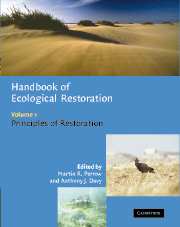21 - Monitoring and appraisal
Published online by Cambridge University Press: 29 December 2009
Summary
INTRODUCTION
Discussing appropriate monitoring of restoration projects within a single chapter is a daunting task. The topic of ecological monitoring can and, indeed, has been the topic of entire books (e.g. Cairns et al., 1982; Clarke, 1986; Spellerberg, 1991; Cairns & Niederlehner, 1995). Given the voluminous literature on the topic and that exact parameters to be monitored will be specific to the system of interest, most of this discussion focuses on questions of monitoring that are applicable to all projects, such as selecting reference systems, temporal and spatial scale, action thresholds, sample distribution, and desirable characteristics of monitoring parameters. Also discussed briefly are the parameters that have been suggested for monitoring specific ecosystem types and considerations of particular importance to those ecosystems; readers are referred to other chapters in this text, however, as well as other literature, to select monitoring criteria for specific ecosystems. Throughout, key points are illustrated with relevant case studies. We draw heavily on the literature in ecotoxicology, as both ecotoxicology and restoration ecology focus on stressed ecosystems and ecotoxicology has a longer history of rigorous monitoring requirements.
Terminology
Regrettably, monitoring is often used to describe three quite different activities: (1) sampling/surveying – gathering data at a particular point in time, (2) surveillance – a systematic and orderly gathering of specific data over a period of time, and (3) monitoring – surveillance undertaken to ensure that predetermined quality control conditions are being met.
- Type
- Chapter
- Information
- Handbook of Ecological Restoration , pp. 411 - 432Publisher: Cambridge University PressPrint publication year: 2002
References
- 36
- Cited by



